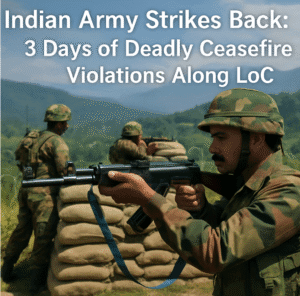Indian Army Strikes Back: 3 Days of Deadly Ceasefire Violations Along LoC
Tensions along the Line of Control (LoC) between India and Pakistan have escalated as Pakistani troops breached the 2003 ceasefire agreement for three consecutive nights, leading to swift retaliation from Indian forces. The latest skirmishes in the Tutmari Gali and Rampur sectors reflect ongoing volatility, heightened by the April 22 Pahalgam terror attack that killed 26. While no casualties have been reported, the security situation in Jammu and Kashmir remains tense, with India intensifying operations to dismantle terror networks.
These violations are part of a broader pattern of ceasefire instability, attributed to geopolitical tensions and cross-border terrorism. Civilians near the LoC continue to suffer from displacement and disruption. Military and diplomatic responses remain calibrated, with India focusing on deterrence and counterterror operations while seeking to hold Pakistan accountable. Despite recent diplomatic protests, the threat of further escalation remains as both nations approach elections. The region’s future stability hinges on addressing cross-border terrorism and renewing dialogue.

Indian Army Strikes Back: 3 Days of Deadly Ceasefire Violations Along LoC
For three consecutive nights, the Line of Control (LoC) dividing Jammu and Kashmir has echoed with gunfire as Pakistani troops breached the 2003 ceasefire agreement, prompting swift retaliation from Indian forces. The latest skirmishes, concentrated in the Tutmari Gali and Rampur sectors, underscore simmering tensions in the region amid heightened security concerns following a recent terrorist attack.
The Immediate Situation
According to defense officials, Pakistani posts initiated small arms fire during the night of April 26–27, marking the third unprovoked violation since April 24. Indian troops responded with targeted fire, maintaining what officials describe as “firm control” along the border. No casualties have been reported, but the repeated incidents highlight a volatile security climate.
Context: Security Crackdown and Regional Instability
The ceasefire breaches coincide with a massive security overhaul in Jammu and Kashmir after the devastating April 22 Pahalgam terror attack, which claimed 26 lives (25 Indian nationals and one Nepali citizen). In response, Indian security forces have launched extensive cordon-and-search operations across Anantnag district, detaining over 175 suspects to dismantle terror networks. Additional checkpoints now dot key highways like Jammu-Rajouri-Poonch, reflecting a state of high alert.
Strategic Hotspots: Why Tutmari Gali and Rampur Matter
The Tutmari Gali and Rampur sectors, though less frequently cited in media, are strategically significant due to their terrain and proximity to infiltration routes. Historical data reveals these areas have witnessed sporadic clashes, often linked to attempts by militants to cross into Indian territory. Their elevation and dense forest cover make surveillance challenging, necessitating robust military readiness.
Broader Patterns: A History of Ceasefire Volatility
The 2003 ceasefire, once hailed as a milestone, has frayed over the years. According to South Asia Terrorism Portal, 2023 saw over 100 ceasefire violations, a spike attributed to geopolitical friction and cross-border terrorism. Experts suggest Pakistan’s actions aim to divert attention from domestic crises or test India’s resolve amid ongoing diplomatic stalemates.
Human Toll: Civilians in the Crossfire
While no civilian casualties were reported in these incidents, villages near the LoC face perpetual disruption. Schools and homes near the border often double as bunkers, and displacement is common during escalations. Local leaders have repeatedly called for reinforced bunkers and emergency response systems to protect residents.
Military and Diplomatic Posturing
Army Chief General Upendra Dwivedi’s recent visit to Srinagar signals India’s proactive stance. His review of counterterror operations and ceasefire dynamics underscores a dual strategy: neutralizing terror threats while deterring Pakistani aggression. Diplomatically, India has consistently lodged protests through established channels, though Islamabad denies involvement in ceasefire breaches.
Expert Insights: Balancing Deterrence and Diplomacy
Security analyst Sameer Patil notes, “India’s calibrated responses—avoiding escalation while asserting dominance—reflect a mature approach. However, sustained pressure via international forums to hold Pakistan accountable for terror infrastructure remains critical.” Others argue for stricter retaliation, citing the ineffectiveness of past diplomatic efforts.
Looking Ahead: Risks and De-escalation
With elections looming in both nations, the potential for calculated provocations rises. Yet, neither side benefits from full-scale conflict. Backchannel talks, as hinted by recent intelligence reports, could offer a off-ramp. Meanwhile, India’s focus on fortifying border tech—like thermal imaging and drone surveillance—may reduce infiltration risks.
Conclusion
The LoC remains a tinderbox, where ceasefire violations serve as both symptom and catalyst of deeper India-Pakistan discord. While the Indian Army’s measured responses prevent chaos, long-term stability hinges on addressing cross-border terrorism and reviving dialogue. For now, residents of Jammu and Kashmir endure a fragile calm, hoping diplomacy can silence the guns.
You must be logged in to post a comment.